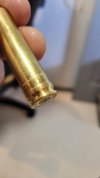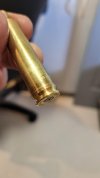In regards to the attached photos and the mask on the case. This is a once fired Peterson 7mmRM in a Browning x-bolt. It is not stretched to failure, at least I checked the inside for a groove using a paper clip and it's smooth all the way around. Rifle has had a case head separation and another that partially split, due too over sizing and loading too many times. That process had been remedied and the whole batch of cases are scrapped.
Question is has the chamber been damaged in that area, burned groove or carbon deposit possibly? Hunting rifle with not alot of shots going through it. How bad will this be for the cases if they are still used? The opposite side of case is clean and smooth.
Question is has the chamber been damaged in that area, burned groove or carbon deposit possibly? Hunting rifle with not alot of shots going through it. How bad will this be for the cases if they are still used? The opposite side of case is clean and smooth.


